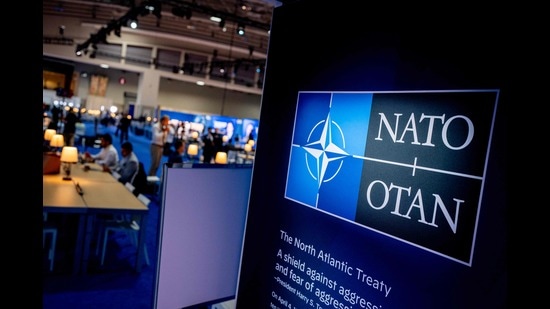Jul 15, 2024 09:02 PM IST
NATO is at a crossroads. While it may have found an immediate purpose in responding to Russia, its challenges extend beyond Moscow.
The North Atlantic Treaty Organization (NATO) marks its 75th anniversary this year, against the backdrop of two significant contexts — the ongoing Russia-Ukraine war and the revitalisation of the Trans-Atlantic alliance. In the first instance, the war has brought the question of Ukraine’s NATO membership to the forefront, with United States (US) President Joe Biden and other European leaders agreeing that Ukraine should have an “irreversible” path to membership. In the second situation, there is a push to future-proof NATO against potential setbacks, especially if Donald Trump wins the US presidential election this November. As such, two strands are pulling the organisation in different directions — celebrations to mark organisational solidarity, reinvigoration and deep uncertainties about its future.

The case for strong collective security in Europe had weakened considerably before the Russia-Ukraine war began. It is not surprising, therefore, that one of the main purposes of NATO’s Washington Summit, held in early July, was to highlight the importance of investing in Europe’s collective defence. The summit also serves an important symbolic purpose to deter Russia, particularly as it is making incremental gains in Ukraine’s east. The signalling comes at a critical juncture in the war. US officials estimate that Russia will be unable to capture large parts of territory from Ukraine in the next phase of the war, given poorly trained troops and critical western supplies to Ukraine that have now become operational. However, on the eve of the Washington summit, Russia launched missile attacks on Ukraine, evincing robust long-range capabilities and an undeterred stance.
The Biden administration is trying to persuade European NATO partners to raise their defence spending to at least 2% of their Gross Domestic Product (GDP), to not only uphold the 2014 pledge to boost European defence and military readiness but also ensure effective extended deterrence for Ukraine. Importantly, increasing defence expenditure could safeguard NATO against potential challenges from Trump, as variable spending from NATO partners has been one of his grievances against the organisation.
Granting NATO membership to Ukraine while the war continues could provoke unpredictable responses from Russia. Moreover, European member countries have collectively been cautious about including Ukraine. Despite these challenges, NATO members took strong steps such as the decision to appoint a NATO Senior Representative in Ukraine; building on the establishment of the NATO-Ukraine Joint Analysis, Training, and Education Centre (JATEC); the decision to establish the NATO Security Assistance and Training for Ukraine (NSATU) and a pledge of long-term security assistance for Ukraine.
Internally, the summit was a pivotal moment for NATO, as it aimed to take irreversible steps safeguarded from leadership changes across the West. NATO focused on bolstering the group’s battlefield credibility by reaffirming its deterrence and defence posture as well as its status as a nuclear alliance. The steps announced towards building Trans-Atlantic defence industrial cooperation are intended to overcome the defence integration and alignment challenges the US has faced in transferring equipment and systems to Ukraine in recent years. These changes come alongside organisational readjustments, with a new secretary general taking over in October and the full integration of Finland and Sweden.
NATO is indeed at a crossroads. While it may have found an immediate purpose in responding to Russia, its challenges extend beyond Moscow. The broader security environment for NATO encompasses strategic competition in the Indo-Pacific, potential systemic shocks from Chinese behaviour, and a pervasive arc of instability extending from Africa to West Asia. The Washington communiqué outlined Iran as a factor impacting Euro-Atlantic security, alongside China’s stated ambitions, and the strengthening China-Russia axis as challenges. It calls China a “decisive enabler” of Russia’s war in Ukraine. Such labelling threatens to widen the gap between two sets of powers. The Washington summit declared that the Indo-Pacific is important for NATO, given that “developments in that region directly affect Euro-Atlantic security”. Pitting China against Russia could, in the long run, pave the way for a broader exploration of partnerships for NATO in the Indo-Pacific. Issues ranging from cybersecurity and counterterrorism to women, peace, and security and human security now form a core agenda of NATO, potentially having ramifications beyond the body’s core Euro-Atlantic focus.
Amidst this churn, the recent visit of Prime Minister Narendra Modi to Russia highlighted India’s potential to bridge a fragmented world order in the making.
Harsh V Pant is vice president for studies, Observer Research Foundation (ORF), and Vivek Mishra is fellow, ORF’s Strategic Studies Programme. The views expressed are personal
Story Saved


